Ice Cream Flavors
Make Creamy Ice Cream Using Condensed Milk
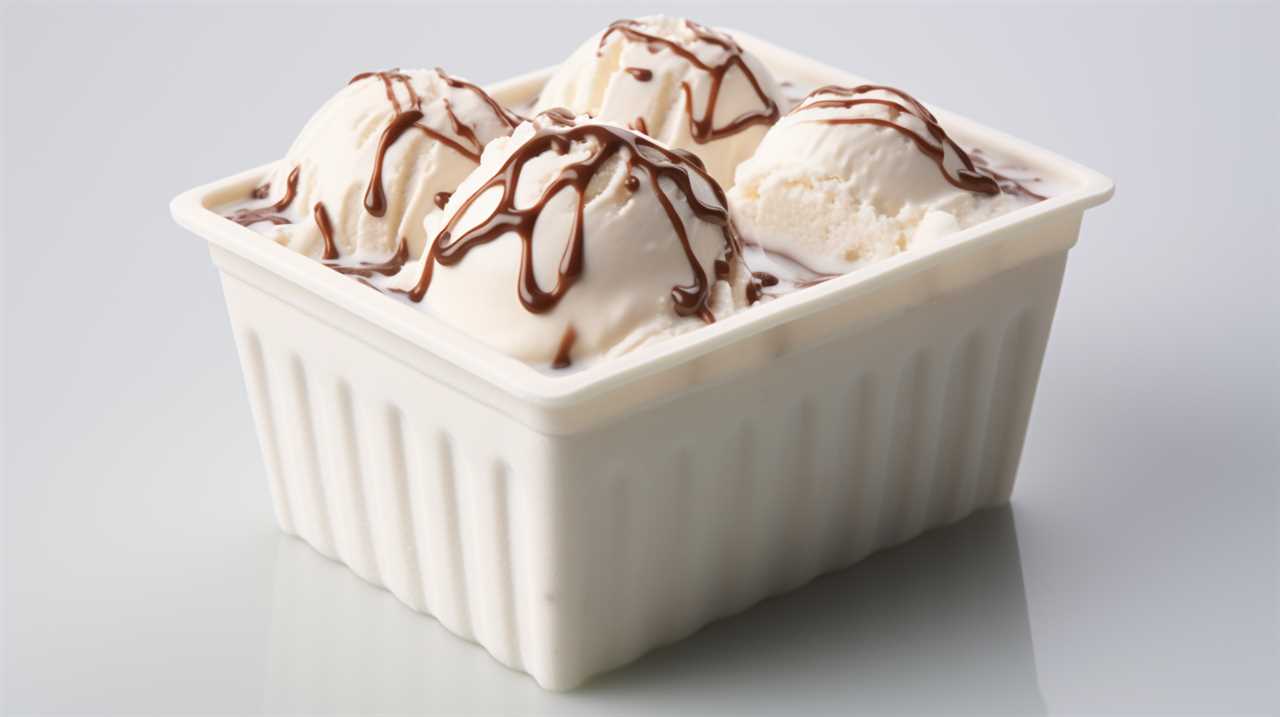
Searching for a rich and tasty treat you can make at home? Look no further! This article will guide you through the process of making ice cream with condensed milk.
Our simple and straightforward directions will guide you through the process, from choosing the right ingredients to churning the perfect ice cream mixture.
With just a few steps, you’ll be enjoying your very own frozen masterpiece in no time.
So grab a spoon and let’s get started on this sweet adventure together!
Key Takeaways
- Consider flavor and texture when choosing sweeteners and experiment with alternatives like maple syrup or agave nectar.
- Get creative with mix-ins like crushed cookies, chocolate chips, or fresh fruit to add extra flavor and texture.
- Enhance the flavor of the ice cream with vanilla extract, cocoa powder, fruit purees, or coffee.
- Use an ice cream maker for even freezing and a creamy texture, and adjust churning time or temperature if needed.
Choosing the Right Ingredients
First, we need to gather the necessary ingredients for making our delicious ice cream using condensed milk.
When it comes to choosing the right sweeteners, it’s important to consider the flavor and texture you desire. Traditional options like granulated sugar or honey work well, but don’t be afraid to experiment with alternatives like maple syrup or agave nectar for a unique twist. The amount of sweetener will depend on your personal preference, so start with a small amount and adjust as needed.
Additionally, don’t forget to consider mix-ins to enhance the flavor and add texture to your ice cream. Popular choices include crushed cookies, chocolate chips, or fresh fruit. Get creative and try different combinations to find your favorite.
Mixing the Condensed Milk Base
Now let’s move on to combining the condensed milk with our chosen sweeteners and mix-ins to create the base for our ice cream. This step is crucial in achieving the perfect texture and flavor.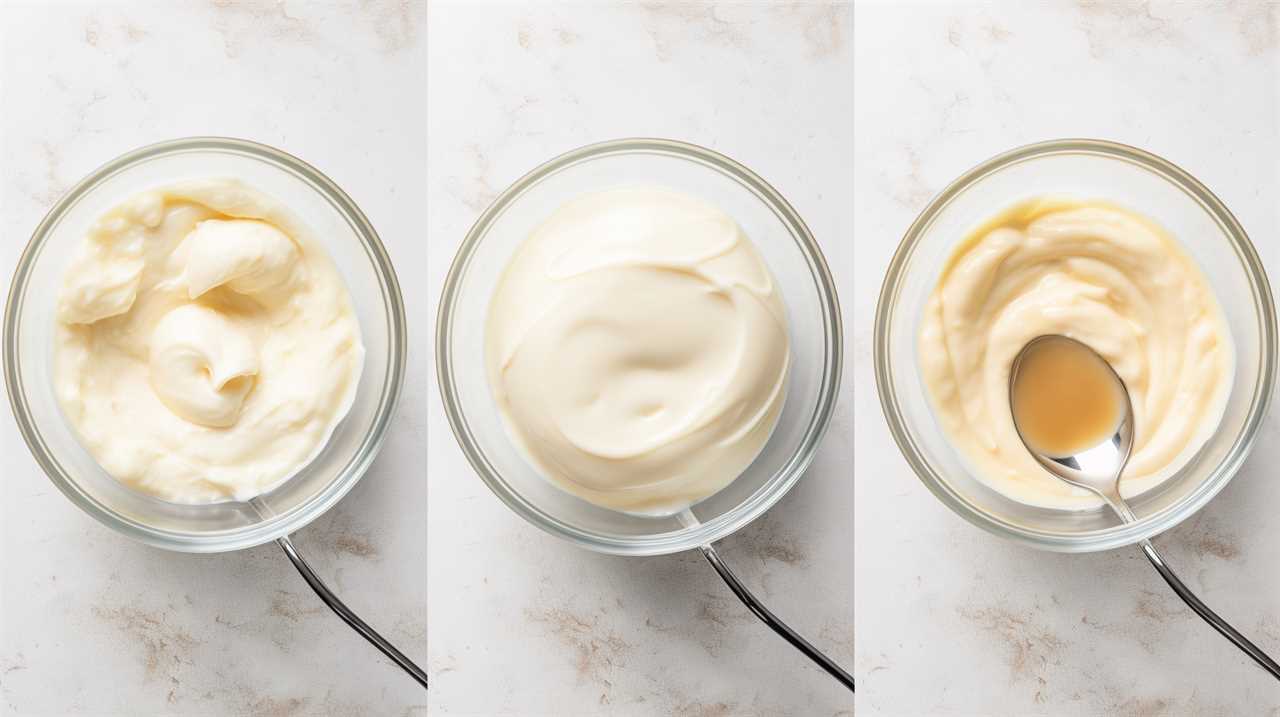
Here are three key points to consider:
- Alternative sweeteners: If you’re looking to reduce your sugar intake or cater to dietary restrictions, consider using alternative sweeteners such as stevia, agave syrup, or maple syrup. These options offer a different taste profile while still providing sweetness to your ice cream base.
- Vegan options: To make your ice cream base vegan-friendly, you can use condensed coconut milk instead of traditional condensed milk. This substitution ensures that your ice cream is free from any animal products while maintaining a creamy and delicious texture.
- Mix-ins: Get creative with your mix-ins to add extra flavor and texture to your ice cream. Whether it’s crushed cookies, fresh fruit, or nuts, these additions will elevate your ice cream experience and make it truly unique.
Adding Your Desired Flavorings
How can we enhance the flavor of our ice cream base using condensed milk?
Adding flavorings to our ice cream mixture is an exciting part of the process. By exploring unique flavor combinations, we can create a variety of delicious ice cream flavors. Whether it’s adding vanilla extract for a classic taste or experimenting with ingredients like cocoa powder, fruit purees, or coffee, the options are endless.
Incorporating mix-ins such as chocolate chips, nuts, or cookie dough can also add texture and surprise elements to our ice cream. The condensed milk base acts as a canvas for our creativity, allowing us to customize our ice cream to our liking.
Once our desired flavorings are added, it’s time to move on to the next step: churning the ice cream mixture.
Churning the Ice Cream Mixture
To churn the ice cream mixture, we’ll need to use an ice cream maker. This machine ensures that the mixture freezes evenly and incorporates air, resulting in a smooth and creamy texture. Here are three reasons why using an ice cream maker is the best choice:
- Consistency: An ice cream maker provides a controlled environment for churning, ensuring that the mixture freezes at the right temperature and creates a consistent texture throughout.
- Efficiency: Using an ice cream maker significantly reduces the churning time compared to alternative methods, such as hand churning or using a blender.
- Troubleshooting: If your ice cream mixture isn’t freezing properly or becomes too icy, an ice cream maker allows you to troubleshoot the issue more effectively by adjusting the churning time or temperature.
Now that we understand the importance of churning with an ice cream maker, let’s move on to the next step: freezing and serving your homemade treat.
Freezing and Serving Your Homemade Treat
Our next step is to freeze and serve our homemade treat.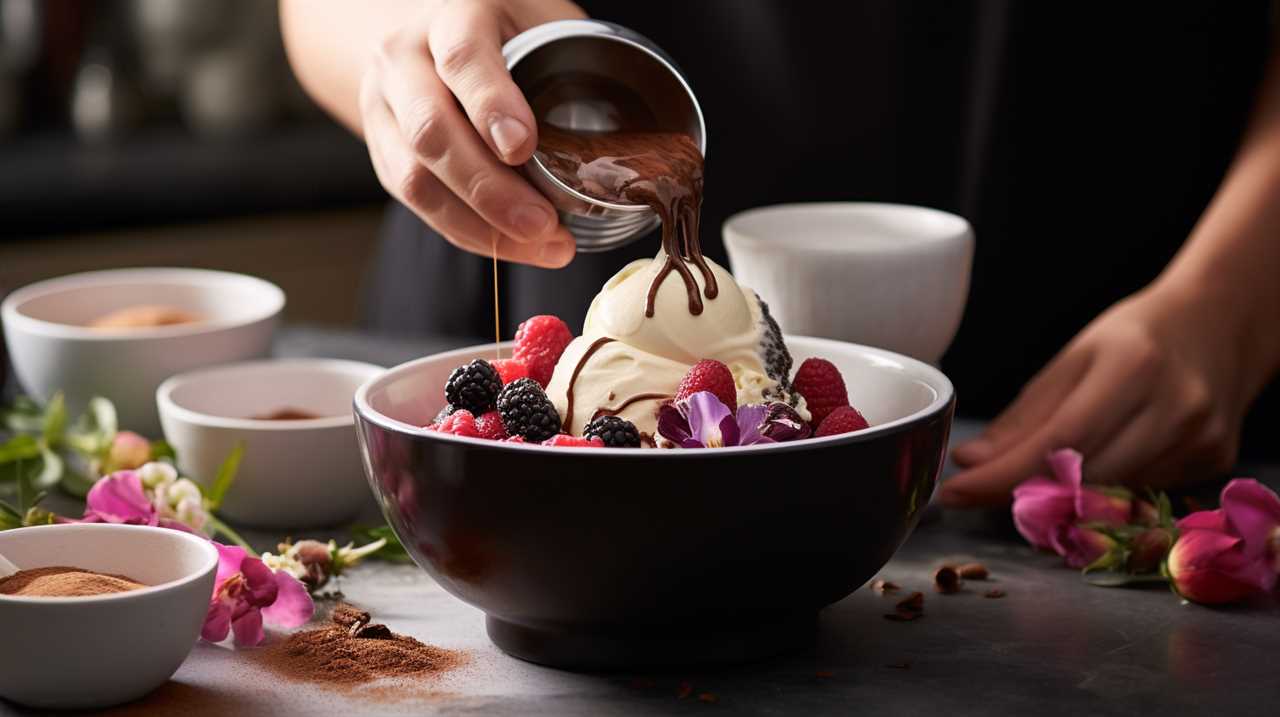
Once you have finished churning the ice cream mixture, transfer it into a freezer-safe container, preferably one with a lid. Make sure to smooth the surface of the ice cream to prevent ice crystals from forming.
Place the container in the coldest part of your freezer, ensuring it’s level and not tilted. Allow the ice cream to freeze for at least 4 hours or until it reaches the desired consistency.
When it’s time to serve, remove the container from the freezer and let it sit at room temperature for a few minutes to soften slightly. Scoop the ice cream into bowls or cones and enjoy!
For serving suggestions, you can top your ice cream with sprinkles, chocolate syrup, or fresh fruits.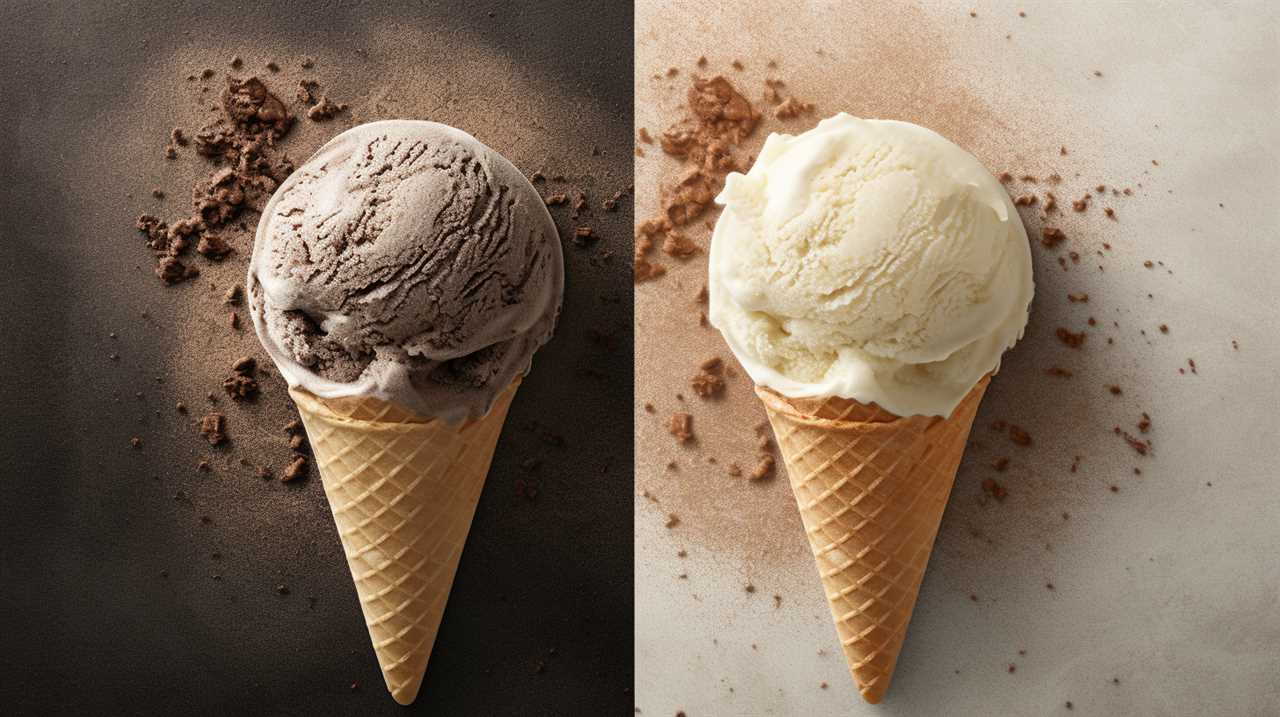
If you have any leftovers, store them in an airtight container in the freezer for up to 2 weeks.
Frequently Asked Questions
Can I Use Regular Milk Instead of Condensed Milk to Make Ice Cream?
Yes, regular milk can be used to make ice cream. There are many homemade ice cream recipes without condensed milk available online. It’s a great option for those who prefer a different taste or have dietary restrictions.
How Do I Prevent My Ice Cream From Becoming Icy and Crystallized?
To prevent our ice cream from becoming icy and crystallized, we’ll need to follow a few steps. By incorporating the right ingredients and techniques, we can ensure a smooth and creamy texture every time.
Can I Use Fresh Fruits as Flavorings Instead of Extracts or Syrups?
Fresh fruit alternatives can be used to flavor ice cream instead of extracts or syrups. However, extracts and syrups offer more precise and consistent flavors. They also have a longer shelf life.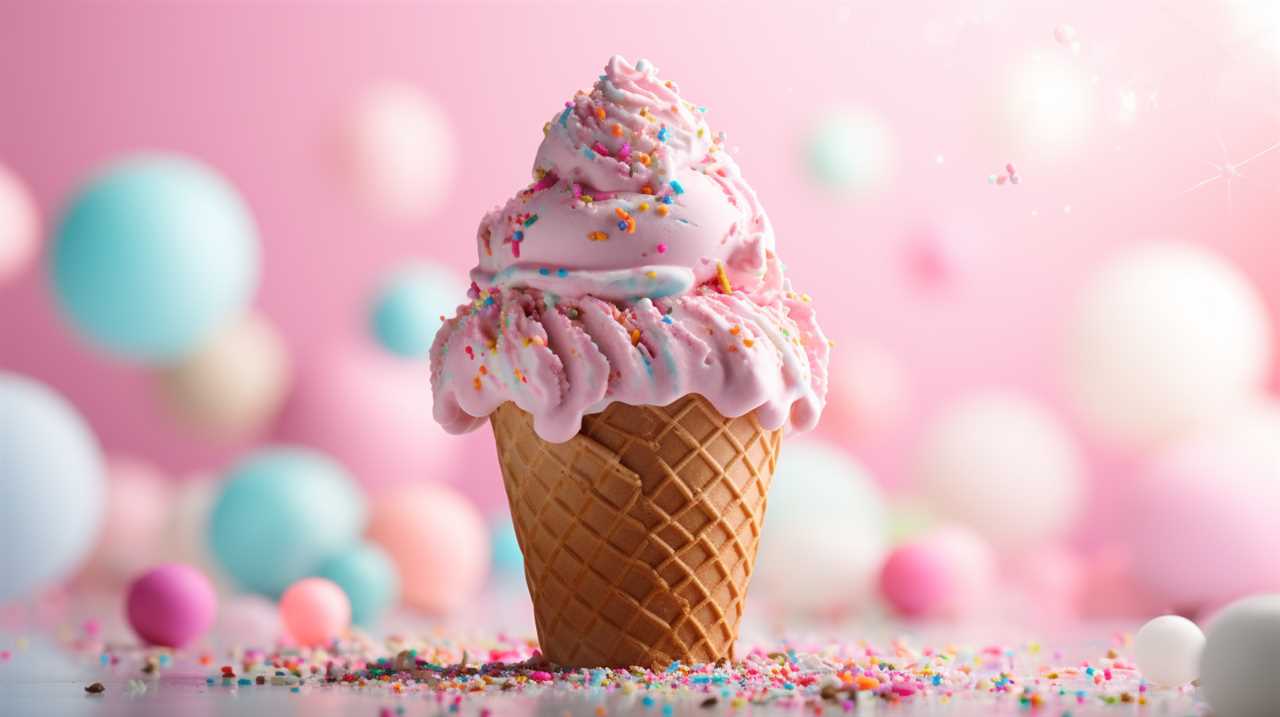
What Equipment Do I Need to Churn the Ice Cream Mixture?
To churn the ice cream mixture, we’ll need the right equipment. There are various options available, from electric ice cream makers to manual churns. Let’s explore these alternatives for a creamy treat.
How Long Can I Store Homemade Ice Cream in the Freezer Before It Goes Bad?
To properly store homemade ice cream, it’s important to minimize air exposure and keep it in an airtight container in the freezer. Factors that cause ice cream to spoil quickly include temperature fluctuations and improper handling.
Can I Use Condensed Milk to Make Fluffy Ice Cream?
Yes, you can use condensed milk to make fluffy ice cream. The key to achieving the fluffy science of ice cream lies in whipping the condensed milk with heavy cream. This process incorporates air into the mixture, resulting in a light and airy texture.
Conclusion
In conclusion, making homemade ice cream using condensed milk is a simple and delicious treat that can be customized with a variety of flavors.
One example of a delightful variation is adding crushed Oreos to the condensed milk base for a cookies and cream flavor.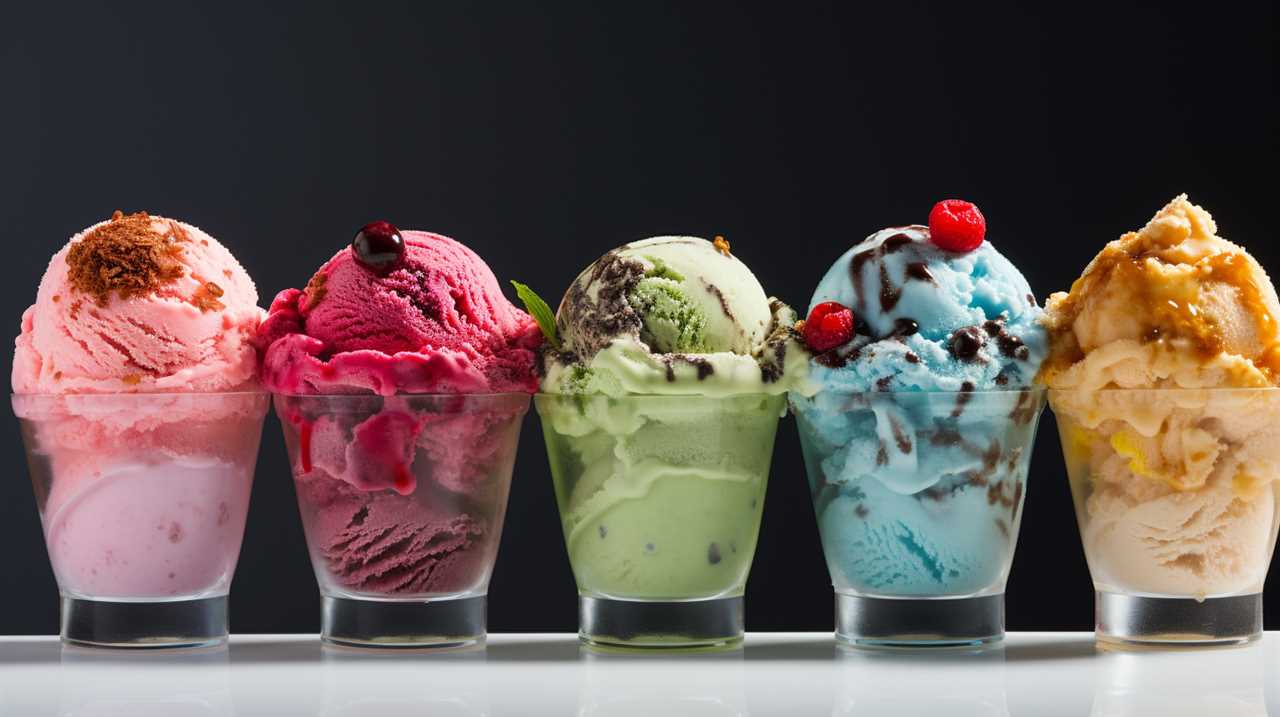
By following the outlined directions and experimenting with different mix-ins, you can easily create your own unique and creamy ice cream at home.
Enjoy the satisfaction of indulging in a homemade frozen dessert!
Beyond the realm of flavor and technique, Adriano recognizes the importance of sustainability and conscious consumption. His writing often explores eco-friendly practices within the ice cream industry, highlighting the use of locally sourced ingredients, reducing waste, and supporting ethical production methods.

Ice Cream Flavors
Delicious Long Ice Cream Flavours You Must Try

Overview of Long Ice Cream
You’ll be amazed at the variety of delicious treats that can come in all shapes and sizes! When it comes to ice cream, there are so many long flavors out there that you may not know where to start. From the classic vanilla and chocolate combinations to more unique flavor combinations, you’ll be sure to find something that satisfies your taste buds. Taste testing is one of the best ways to explore the world of long ice cream flavors. Sample as many different flavors as possible before deciding on which one suits your palate best. But don’t stop with just a few scoops; mix-in some creative toppings for an added level of flavor and texture. Whether you’re trying new or classic combinations, your options are virtually endless when it comes to creating your own special blend of long ice cream flavors. From familiar favorites like mint chip and rocky road, to exotic sorbets like passionfruit and lavender honeycomb, unique ice cream flavors offer a world of possibilities for any palate. Get creative by mixing two or more flavors together for a truly unforgettable experience. Try combining strawberry cheesecake with coconut or cookie dough with peanut butter – the options are only limited by imagination! If you want something truly special, add unexpected ingredients such as black sesame seeds or rose petals for an ultra-indulgent treat. With these unusual ingredients, no two desserts will ever taste exactly alike! No matter what type of dessert experience you’re looking for, there’s sure to be a long ice cream flavor combination that fits the bill perfectly – whether it’s classic indulgence or extraordinary innovation that tickles your fancy. With so many mouthwatering possibilities available at your fingertips, summer days have never been sweeter!Unique Ice Cream Flavors
I’m so excited to talk about some of the most unique ice cream flavors out there! Salted Caramel, Maple Bacon, Honey Lavender, Chocolate Chili and Avocado are all on the menu. Each flavor is sure to bring a new twist to your taste buds. Whether you’re looking for an adventurous bite or something more traditional, these flavors will definitely give you something to talk about!Salted Caramel
Savour the rich, creamy taste of salted caramel and experience a flavour like no other. With just a hint of salt and a smooth aftertaste, salted caramel is the perfect way to satisfy any sweet tooth. A popular treat for both adults and children alike, it can be used in a variety of recipes such as salted caramel cupcakes or salted caramel popcorn. The combination of sweetness and saltiness creates an irresistible balance that’s sure to leave you wanting more. This unique flavour has become increasingly popular over recent years due to its complexity and versatility – transforming ordinary desserts into extraordinary treats! Whether you’re looking for something special to bake or just want a delicious snack that won’t break the bank, salted caramel is sure to make your taste buds dance with delight. And with its ever-growing popularity, there’s no denying that this flavour will be around for many summers to come – ready to tantalize everyone’s taste buds! Now, let’s move on from this delectable treat and delve into the world of maple bacon…Maple Bacon
Indulge in the mouth-watering combination of maple bacon and tantalize your taste buds with an unforgettable flavor. Maple bacon ice cream is a unique twist on the classic flavor, offering different variations to make it your own. Here are a few ideas to get your inspiration flowing:- Try adding some crunchy bits of bacon as a topping.
- Create a sundae with maple syrup and crushed up bacon bits.
- Pair it with waffles or pancakes for an extra special treat.
- Use it as an ice cream sandwich filling between two cookies.
- Make a milkshake blended with ice cream, milk, and pieces of bacon.
Honey Lavender
Discover the delightful harmony of honey and lavender for a truly captivating experience. If you’re looking to add a unique twist to your next ice cream recipe, look no further than this combination of flavors. Sweet honey infused recipes are taken to the next level with just the right amount of lavender infused treats. The floral notes from the lavender blend perfectly with the subtle sweetness of honey, creating an unforgettable taste that is sure to leave you wanting more. There’s nothing quite like it – chocolate chili may be up next but nothing will ever compare to this delicious combination!Chocolate Chili
Experience the thrill of chocolate and chili in a single bite for an unforgettable taste sensation! Chocolate chili is one of the most innovative ice cream flavors to come out in recent years. This combination may seem unusual at first, but it creates a unique balance between sweet and spicy that will leave your taste buds wanting more. Traditional dessert flavors like vanilla or strawberry are still around, but they don’t offer the same level of excitement that this creative concoction does. The spiciness from the chili peppers offsets the sweetness of the chocolate perfectly – allowing you to enjoy each flavor individually while experiencing them together as well. Plus, these two ingredients pair nicely with other traditional chili desserts like churros and sopapillas, making them even more enjoyable. As you can see, this isn’t just any ordinary ice cream flavor – it’s one that will leave you wanting seconds! To continue this exciting journey into uncharted territory, let’s move on to talking about avocado ice cream next.Avocado
Tantalize your taste buds with the smooth, creamy texture of avocado ice cream – a unique and unexpected treat! This flavor combines the mellow sweetness of avocado with either rich chocolate or smooth vanilla for an extraordinary combination. The subtle yet distinctive taste of avocado adds a depth to the classic flavors, creating an exciting twist on traditional favorites. Try blending chunks of fresh avocado into a creamy chocolaty base or folding in pureed avocados to lighten up a classic vanilla flavor. Whatever you choose, you’re sure to enjoy this one-of-a-kind creation that will leave your mouth watering for more! Moving on from unconventional flavors like Avocado, let’s explore some classic favorites with their own special twist.Classic Flavors with a Twist
Try something new and get a classic flavor with an unexpected twist! From fusion flavors to regional favorites, there are plenty of options that offer the best of both worlds. Here’s a list of three unique combinations that will satisfy your sweet tooth:- Salted Caramel – A decadent mixture of salty and sweet.
- Toasted Marshmallow – Creamy vanilla ice cream mixed with lightly toasted marshmallows for a hint of smokiness.
- Cookies & Cream – The classic combination of crushed Oreos and creamy vanilla ice cream never gets old!
Asian-Inspired Flavors
As someone who loves to experiment with flavors, I’m always on the lookout for new and interesting ice cream options. Recently, I’ve been exploring Asian-inspired flavors, specifically Matcha Green Tea and Black Sesame. Both have unique yet delicious notes that make them a great addition to any ice cream parlor or home kitchen!Matcha Green Tea
Make your taste buds dance with the sweet and earthy flavor of Matcha Green Tea! Did you know this special powder made from green tea leaves is a powerful source of antioxidants? Enjoying Matcha Green Tea can provide your body with a variety of health benefits, such as improving cholesterol levels and reducing inflammation. Plus, there are many delicious recipes that use this versatile ingredient. From smoothies to cakes and cookies, the possibilities are endless when it comes to Matcha recipes. The next time you’re looking for something unique to satisfy your sweet tooth, why not give Matcha Green Tea a try? Your taste buds will thank you! With its creamy texture and nutty flavor, Black Sesame is another tasty treat worth exploring.Black Sesame
After trying the delicious Matcha Green Tea ice cream, I was looking for something different and unique. So I decided to try out the Black Sesame flavor. This flavor is a unique combination of sweet and savory that goes well with any dessert. It has a nutty, earthy flavor that is sure to please anyone’s palate! Black sesame is often known for its health benefits as it contains many antioxidants, vitamins, minerals, and fiber. It also contains zinc and iron which are essential for healthy skin. Furthermore, black sesame can help in maintaining healthy blood pressure levels and promoting heart health. As for recipes, you can use black sesame paste in cakes or cookies or even make your own ice cream! With this delicious flavor as an option at my local ice cream parlor, I’m now excited to explore other fruit-based flavors that they have to offer.Fruit-Based Flavors
I’m excited to explore the world of fruit-based flavors! From sweet and juicy mangoes to tart and tangy raspberries, all the way to succulent strawberries – there’s a flavor for everyone! These three fruits are popular picks when it comes to ice cream, so let’s take a look at how they can be used in delicious frozen treats.Mango
Mango ice cream is a delicious treat that’ll make you feel like summer all year round – and don’t worry, it won’t melt too quickly! This tropical-flavored treat provides the perfect balance of sweet and tart. Mango sorbet is a great dessert option for those who want something lighter than traditional ice cream. For a cool, creamy experience, try adding some mango milkshake to your scoop of mango ice cream. The combination of cold and smooth will be sure to satisfy any craving. Plus, the bright yellow hue of mango can make for an eye-catching presentation in whatever form you choose! As with any frozen treat, there are endless possibilities when it comes to creating your own unique version of mango ice cream or sorbet. Whether you prefer it blended into a thick milkshake or served over your favorite cake or brownie, this flavor will always bring out smiles from everyone around the table. To transition into the next subtopic without saying ‘step’, let’s explore the world of raspberry now — another popular fruit-based flavor!Raspberry
Mango ice cream was a great way to start the conversation about long ice cream flavors, but now I’m ready for something new. Raspberry is definitely the next flavor on my list! Making raspberry ice cream requires fresh raspberries, heavy cream, and sugar. The combination of sweet and tart makes raspberry ice cream an exciting way to indulge in this classic summer dessert. Raspberry can also be combined with other flavors like dark chocolate or coconut to create unique flavor combinations that will tantalize your taste buds. This creamy concoction is perfect for a hot summer day or to serve at a small gathering. With its bright flavor and refreshing taste, raspberry ice cream is sure to please everyone’s palate. But I’m not done yet – let’s move on to strawberry next!Strawberry
You’ll love the sweet and tart flavor of strawberry ice cream, an exciting alternative to traditional summer desserts. Not only is it delicious, but it also has a number of health benefits. Strawberries are a great source of antioxidants that can help reduce the risk of chronic diseases such as heart disease and cancer. They also provide essential vitamins and minerals like vitamin C, potassium, fiber, folate, and manganese. If you’re looking for more ways to enjoy strawberries in your diet, why not try making a healthy strawberry smoothie? There are hundreds of recipes online that use fresh or frozen strawberries, so you can enjoy this nutritious treat any time! Nut-based flavors are another great way to enjoy ice cream without sacrificing taste or nutrition. From classic peanut butter swirls to exotic cashew caramel concoctions, nut-based ice creams offer something for everyone’s palate. Enjoy the creamy texture while still getting all the protein and healthy fats your body needs!Nut-Based Flavors
If you’re a fan of nuts, then you’ll love these nut-based flavors! From the classic Peanut Butter Chunk to the more exotic Almond Crunch, there are so many options available. If you have a sweet tooth, why not try adding some Nutella or chocolate chips to your ice cream? Not only will it add an extra layer of flavor but also provide an interesting texture. Alternatively, if you prefer something savory, why not sprinkle some crushed peanuts or hazelnuts over your favorite ice cream? This salty-sweet combination is sure to tantalize your taste buds and keep you coming back for more. Nuts are full of essential vitamins and minerals that can benefit your health in numerous ways. They are a great source of healthy fats and can help reduce cholesterol levels. Additionally, they contain fiber which helps with digestion and can even help with weight loss. With all these health benefits already packed into them, it’s no wonder why so many people choose nuts as their go-to topping for delicious and nutritious desserts! From crunchy to creamy, nut-based flavors offer something for everyone – whether they want to indulge their sweet tooth or snack on something healthy. Experimenting with different combinations is all part of the fun when it comes to creating unique long ice cream flavours – just don’t forget about alcohol-infused ones too!Alcohol-Infused Flavors
I’m excited to discuss alcohol-infused flavors! From Baileys Irish Cream to Rum Raisin, these flavors can add a unique twist and interesting complexity to your favorite ice cream. They also offer an adult-friendly treat that is sure to please the palate of those looking for something special. Let’s explore the possibilities of these delicious flavors!Baileys
Prepare to indulge in the luxurious taste of Baileys – a truly decadent treat! This alcohol-infused ice cream flavor is made with real Irish cream, and it’s sure to tantalize your taste buds. Here are just some of the reasons why you’ll love Baileys:- Its rich aroma will draw you in for more.
- It has a hint of whiskey that adds depth to the flavor.
- Its subtle sweetness will make your mouth water.
- Its velvety smooth texture will melt in your mouth.
Rum Raisin
After sampling the sweet, creamy flavor of Baileys, I was ready to move on to a classic favorite – Rum Raisin. This flavor has been around for nearly a century, first created in the 1920s by a British ice cream maker who wanted to add something special to his creations. The rum raisin combination quickly became an iconic part of ice cream history. Rum raisin is one of the most versatile flavors available because it can be used in so many different variations. While some recipes just use rum and raisins, others incorporate things like cinnamon and nutmeg for added spice or nuts and chocolate chips for crunchy texture. There are even vegan versions that use coconut milk as the base instead of traditional dairy products! No matter which variation you choose, you can expect a decadent treat that satisfies your taste buds.Decadent Flavors
Treat your taste buds to the decadent flavors of ice cream! From classic favorites like chocolate and vanilla, to more daring flavor combinations such as pumpkin spice and salted caramel, there is something for everyone. Whether you’re a fan of traditional tastes or prefer something out of the ordinary, here are some decadent flavors worth trying:- Caramelized banana – a delicious combination of creamy banana ice cream with ribbons of sweet caramel
- Vanilla bean cheesecake – this indulgent treat blends rich cream cheese with vanilla bean ice cream
- Chocolate fudge brownie – a chocoholic’s dream come true featuring chunks of fresh brownies in a smooth chocolate base
Seasonal Flavors
Moving from decadent flavors to seasonal flavors, I’m reminded of the ever-changing nature of ice cream. With each passing season comes a new set of special offerings that are made available for a limited time only. Whether it’s pumpkin spice during fall or peppermint bark during winter, seasonal ice cream flavors offer something unique and exciting for everyone. The availability and variety of seasonal flavor options can vary greatly depending on where you live. In some parts of the world, mangoes may be in season while other places feature strawberries instead. Regional variations can also make a difference when it comes to finding the most delicious treats as certain areas may specialize in specific types of produce that have been used to create regional favorites like huckleberry ice cream in Montana. Whether you’re looking for something classic or something unique, there’s sure to be an option that will tantalize your taste buds. With so many different possibilities available, it’s no wonder why people look forward to their favorite seasonal flavors every year! As we wrap up our discussion on seasonal flavors, let’s look ahead at vegan-friendly varieties that provide an alternative for those with dietary restrictions.Vegan-Friendly Flavors
Vegan-Friendly Flavors provide a delightful alternative for those with dietary restrictions, like a breath of fresh air on a hot summer day. With vegan substitutes replacing dairy and other animal-based ingredients, ice cream lovers everywhere can indulge without feeling guilty. Ethically sourced ingredients add an even greater depth to the delightfully unique flavors available:- Coconut & Mango – A tropical treat combining creamy coconut milk with the sweet zing of ripe mangoes.
- Peanut Butter & Jelly – An old favorite gets a vegan makeover! Enjoy this classic combination without any animal products.
- Strawberry Basil – Sweet strawberries are balanced out by earthy basil in this refreshing take on fruity ice cream.
Frequently Asked Questions
What is the difference between long ice cream and regular ice cream?
When it comes to ice cream, there is a distinct difference between long ice cream and regular ice cream. Regular ice cream is usually thicker in texture than long ice cream, which has a creamier consistency. When it comes to taste, long ice cream offers a subtle sweetness while regular ice cream tends to be much sweeter. Long ice creams tend to have fewer ingredients than regular ones, making them lighter and easier to digest. The two varieties also differ in appearance as regular ice creams are typically more colorful and vibrant while long ones are milky white or pale yellow in color. Ultimately, the choice between the two types of frozen treats depends on individual preference; both offer unique tastes and textures that make them worth trying!Are there any dietary restrictions associated with long ice cream?
I was surprised to learn that there are a variety of dietary restrictions associated with long ice cream. For those who are avoiding dairy, there are plenty of dairy-free options available. And for vegans, there are even vegan alternatives! Furthermore, many companies offer unique flavor combinations such as strawberry and peanut butter or mango and coconut. This is great news for those looking for something new and innovative in the realm of desserts. Whether you’re lactose intolerant or vegan, you can still enjoy some delicious long ice cream flavors without having to worry about dietary restrictions!How long do long ice cream flavors last?
When considering purchasing a long ice cream flavor, one of the major questions that arises is how long it will last. This is important to consider when making an informed purchase decision as you want to make sure that you’re getting the most bang for your buck. Cost comparison and taste comparison should be taken into account, but so too should how long this flavor will last. On average, these flavors tend to have a shelf life of about three weeks. However, if stored properly in a cool and dry place, they can sometimes last up to two months before losing their flavor and texture.Is it possible to make long ice cream at home?
Making homemade ice cream is totally possible, and it can be a fun and creative way to experiment with flavors. With just a few ingredients and some substitutions, you can make an incredible variety of long ice cream flavors. One interesting statistic to consider is that over 84% of households in the US have at least one type of frozen confectionary in their freezer! For those looking for something more unique than store-bought, creating unique recipes from scratch can be incredibly rewarding. By experimenting with different flavors and combinations, you can create your own delicious, long-lasting creations. Whether you’re making classic favorites or innovating new ones, making homemade ice cream at home has never been easier!How can I find the best long ice cream flavors?
I’m always on the search for the best ice cream flavors, and long ice cream flavours are no exception! Exploring taste can be a fun way to discover something new. With a variety of flavors out there, I’ve learned that it’s important to do your research before you buy. Look online for reviews or talk to people about their favorite flavor. This can help you find one that fits your unique palate. Whether you’re looking for classic favorites like chocolate and strawberry or more adventurous combinations like honeycomb and figs, there’s sure to be something that satisfies your taste buds. So don’t be afraid to explore! With enough research, you’ll find the perfect long ice cream flavor.What Are Some of the Best Long Ice Cream Flavors Offered by the Top Ice Cream Brands?
Many leading ice cream brands present a wide array of long-standing ice cream flavors that showcase the creativity and variety available in the industry. Ranging from time-honored flavors such as vanilla and chocolate to distinctive tastes like salted caramel and mint chocolate chip, the assortment of flavors offered by the premier ice cream brand stands out in fulfilling all kinds of desires.
Conclusion
I’m sure I’ve barely scratched the surface of long ice cream flavors! There are just so many delicious flavors to explore. From classic favorites with a twist, to Asian-inspired creations, there’s something for everyone. Plus, you can even find vegan options and seasonal specialties like pumpkin spice or eggnog. And if you’re feeling daring, why not try one of the more decadent flavors with an alcohol kick? No matter what kind of ice cream flavor you choose, it’ll be sure to transport you back in time – like a cool summer blast from your childhood.Beyond the realm of flavor and technique, Adriano recognizes the importance of sustainability and conscious consumption. His writing often explores eco-friendly practices within the ice cream industry, highlighting the use of locally sourced ingredients, reducing waste, and supporting ethical production methods.
Ice Cream Flavors
Which Ice Cream Brand Reigns as the Best?
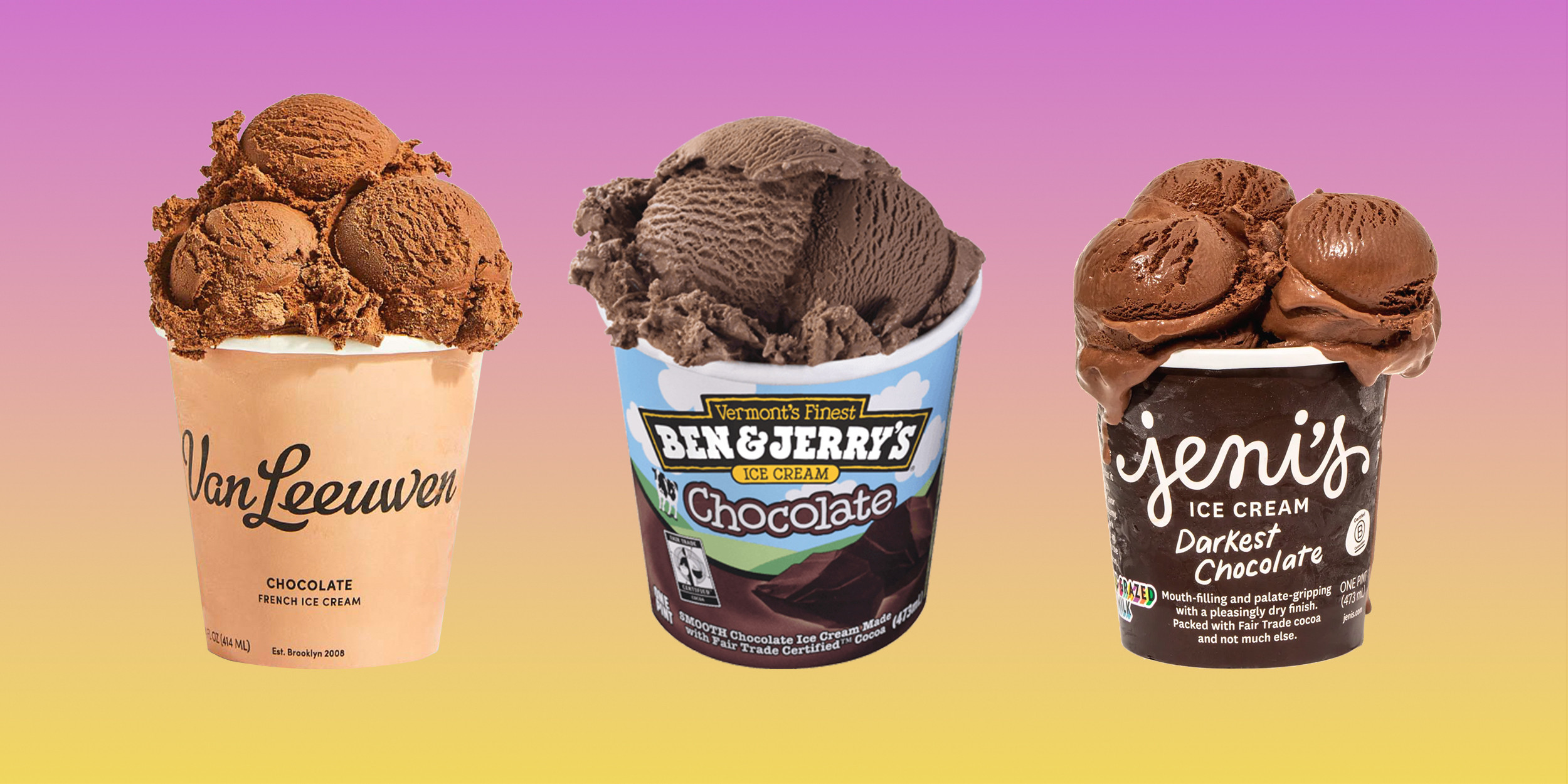
After stopping by your favorite spot for ice cream and savoring a delightful sundae, you find yourself mulling over the perfect ice cream selection. Fear not, we’re on hand to assist! We’ve gathered a compilation of the finest ice creams throughout the United States. No matter if plant-based variations are your thing or if you lean towards classic tastes, we’ve ensured to cater to all your needs!

Edy’s/Dreyer’s
It’s easy for EDY’S(r), (Dreyer’s) icecream to be a beloved treat for almost a century. The company has six delicious flavors to choose from, in addition to the fact that it is one of the best ice creams available. One of these is Rocky Road, an ice cream treat that’s undoubtedly the best.
The original Rocky Road is just one of the six flavors in the new Rocky Road Collection. This collection is a homage to the O.G., a nod to the original, and a tribute to a delicious mix-in.
Bluebell
Blue Bell is a well-known ice cream brand. It is sold in 23 states and is the third most popular ice cream brand in America. Blue Bell uses no artificial flavors or additives, unlike many other ice cream brands.
Blue Bell makes a variety of popular ice creams and frozen yogurt products. They also make a line of sherbet and Country Cones. Their vanilla ice cream is undoubtedly the best.
In addition to their standard vanilla, Blue Bell produces flavors such as Blue Bell Birthday Cake and Cherry Vanilla. These ice creams are delicious but they are not the only ones that deserve to be on your dessert table.
High Road
High Road Ice Cream is a high-quality craft ice cream producer that has a reputation for making delicious flavors. Its product is sold in a variety of retail and foodservice outlets throughout the United States.
The company was founded in 2010 by Keith Schroeder and his wife, Nicki Schroeder. They are both culinary experts. Their goal was to help restaurants create a better tasting ice cream dessert.
Initially, the company worked exclusively with chefs to develop its signature flavors. Now, the company manufactures branded ice cream, gelato, and sorbetto.
Hood
If you’re looking for a delicious ice cream to satisfy your sweet tooth, you’ll definitely want to check out Hood Ice Cream. Known as one of the most popular treats in New England, this tasty ice cream is made with premium ingredients and will delight your taste buds.
Hood is a well-known brand that has been around over 100 years. It can be found in many local grocery stores. It is also available at a variety ice cream shops.
Hood uses a combination of high-tech and low-tech production techniques to create its ice cream. Hood has an on-site laboratory and uses third-party labs for quality control.
Nectar of the Queens
Nectar of the Queens is a flavor that’s new to Ample Hills Creamery. Named after the neighborhood’s Greek heritage, it’s an innovative combination of honey cinnamon ice cream and local baklava. It’s also a great way to honor the Greek community, whose traditions and cuisine are very much alive and well in Astoria.
The Nectar of the Queens is usually only available at Ample Hills’ scoop store in Astoria. But the ice cream purveyor is bringing it to its first location in Long Island City. The building used to house a security system firm, but it’s been converted into an ice cream parlor.
So Delicious
So Delicious ice cream is not only vegan but it’s a healthy alternative to conventional ice cream, as well. The company has been making the dairy-free ice cream of choice for over a decade. It has many tricks up its sleeves, including a variety of new flavors that will keep you coming back for more. Among the more interesting are a trio of chocolate coconut milk ice creams, the aforementioned oh-so-sweet chocolate and a coconut macaroon ice cream, along with a couple of ginormous gelatos.
So Delicious ice creams can be expensive, but they are often very affordable if you know where you look. Walmart sells their dairy free goodies in bulk, and will deliver in some locales. Several grocery chains also carry the line, including Whole Foods.
What Sets the Best Ice Cream Brand Apart from Others?
When it comes to choosing the best ice cream brand, it’s important to consider the fascinating ice cream rod facts that set certain brands apart from others. From unique flavors and high-quality ingredients to innovative packaging and sustainable practices, these fascinating ice cream rod facts can make a brand stand out in a crowded market.
Plant-Based
Plant-based icecream is becoming more popular than traditional icecream. These frozen desserts are very popular among people who love the taste but want a healthier alternative.
According to Innova, the market for plant-based icecream is expected to grow at 12.6% CAGR through 2024 according to a report. A growing number of consumers are concerned about factory farms and the global climate crisis, and plant-based foods are one of the milking opportunities for those who are seeking a healthier lifestyle.
Beyond the realm of flavor and technique, Adriano recognizes the importance of sustainability and conscious consumption. His writing often explores eco-friendly practices within the ice cream industry, highlighting the use of locally sourced ingredients, reducing waste, and supporting ethical production methods.
Ice Cream Flavors
Which Ice Cream Flavor Was Invented First: A Historical Guide

When it comes to ice cream, a frequent question concerns the original flavor that was created. Various options are considered, including vanilla, salted caramel, and sorbet. These flavors provide a pleasing taste sensation and are even accessible as frozen drinks!
The first ice cream flavor is difficult to determine, as ice cream has been around in some form for many centuries.
However, it is believed that the first flavors of ice cream were very simple, such as just cream and sugar. As time passed, other ingredients, such as fruit, nuts, and spices were added to create new flavors. Some historians believe that the first ice cream flavor was a simple mixture of cream and honey, which the ancient Romans enjoyed.
Others believe that fruit-flavored ice cream, made with fruit syrups and purees, was the first flavor to be enjoyed. Ultimately, it is difficult to say for sure which ice cream flavor was invented first.
Vanilla
Vanilla ice cream has been around for centuries. Although its origins are unknown, it is believed that vanilla ice cream was the first frozen dessert to be introduced into the world.
Vanilla is a rich flavor. It is also very deep, which is why it is the most popular flavor for ice cream. However, early ice cream makers did not use vanilla beans. Instead, they added the vanilla to the ice cream when it was close to boiling.
The first recorded recipe of vanilla ice cream in the United States was written by Thomas Jefferson. After meeting Adrien Petit, a French dessert specialist who specialized in vanilla ice cream, he is believed to have brought the recipe from France.

During his time in France, Jefferson had a large stock of French recipes. One of them was a recipe for a gourmet style vanilla ice cream. This recipe is kept at the Library of Congress.
Salted Caramel
Henri Le Roux (a French chocolatier) created the first salted caramel-flavored ice cream in 1960. His creation was a big hit. It was so popular that it was named the “best sweet” in France in 80.
Salted caramel is now one of the most popular flavors in the dessert industry. It can be used to flavor many foods, including yogurt and coffee. In fact, it’s become such a popular flavor in North America that it’s been marketed by companies as a specialty food item.
It started out as an ice cream, but a gourmet version has also been created. Some have added crushed pretzels or honey-glazed bacon bits.
This is a combination of a sweet and salty flavor that really does double the pleasure. It’s a great way to showcase the perfect balance of flavour profiles.
Soft ice cream
Soft ice cream is a soft ice cream with a lower fat content. It is made from a liquid mixture and then frozen by a special machine. It is often served in a cone with a Cadbury’s Flake topping.
Soft serve ice cream is very popular in the United States. It is available from many local brands. It is also claimed that the product was invented by major brands like Dairy Queen or Carvel.
Soft ice cream was popularized in the late 1940s, when it became more affordable. Tom Carvel opened his first ice cream shop in 1936. He sold partially melted creams to vacationers. After he perfected his recipe, he began selling it to people passing by.
Sorbet
Sorbet is an ice cream flavor that can be served chilled. The flavor is usually a fruit like strawberry, mango, banana or citrus. It is a healthier alternative to ice-cream.
It is made from water, sugar, and flavorings. In some cases, it is a dairy free product. It is often sold in restaurants as a dessert.
Sorbet is considered the ancestor of ice cream. Although it has been around for almost as long as ice cream, it is a much different product. It is made of sugar and water and has a soft texture than ice-cream. It is usually made in an ice-cream maker. You can freeze it and then cut it into different shapes.
Sorbet was first discovered in the Middle Ages. It was a popular drink in the Arab world. People would consume it during winter as a icy refreshment. Originally, it was flavored with quince, pomegranate, or cherry. It became a popular choice among European aristocracy.
Origins
Ice cream’s origins are more fascinating than you might think. While we are accustomed to reading about the invention of the modern ice cream we often overlook the fact that the earliest versions of this delicious treat were made in the Middle East and Europe.
Iced drinks were a common practice in the ancient world. King Solomon, for instance, enjoyed cooling a drink flavored with honey during harvesting.
Arabs also experimented with a variety of ingredients, including snow, milk, and fruit. One of the most popular flavors today is vanilla. Although the origins of ice cream are uncertain, it is known that a recipe for sherbet was written down in Italy around the 16th century.
In the 18th century, France’s Catherine de Medici introduced ice cream to the country. Henry II of France, her husband, was the king of France.
Mario’s creativity shines through his ability to describe the sensory experience of enjoying ice cream. Whether he’s discussing the velvety texture, the explosion of flavors, or the delightful combinations of toppings and sauces, his words transport readers to a world of mouthwatering sensations. His descriptive language allows readers to imagine and savor the flavors even before taking the first bite.
-

 Beginners Guides1 week ago
Beginners Guides1 week agoCreamy Remedies: Good Ice Cream Choices for Acid Reflux Relief
-

 Beginners Guides1 week ago
Beginners Guides1 week agoHow to Do When Your Ice Cream Tastes Gritty: Quick Fixes
-

 About Ice Cream4 weeks ago
About Ice Cream4 weeks agoWhat Military Diet Rules Allow Ice Cream?
-
Beginners Guides5 days ago
10 Differences Between Ice Cream and Popsicles
-

 Creative Ice Cream Recipes2 weeks ago
Creative Ice Cream Recipes2 weeks agoWho Makes Dairy Queen Ice Cream
-

 About Ice Cream4 weeks ago
About Ice Cream4 weeks ago10 Reasons Why You Feel Like Throwing Up When You Eat Ice Cream
-

 About Ice Cream4 weeks ago
About Ice Cream4 weeks agoHow Pouring Milk on Ice Cream Causes Ice Crystals
-

 About Ice Cream4 weeks ago
About Ice Cream4 weeks agoWhat Makes Ice Cream Essence Essential in Creamy Treats?



















